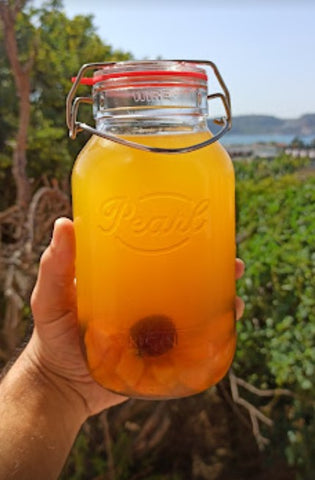Fermenting foods for beginners! Avoid these 3 mistakes
Check our fermenting food for beginners guide! Are you wondering what mistakes you might be making when it comes to fermentation? Then this is the blog post for you. Our Pearl team shares three simple mistakes to avoid for beginner fermenters that will help you fool-proof your fermenting results in the kitchen.
Happy fermenting!
1. Keep your ferments submerged
Making sure that the contents of your mason jar are fully submerged is a step often overlooked, that is why we wrote this fermenting foods for beginners guide. It is very important that everything is submerged beneath liquid during the fermentation process, otherwise, you are creating an environment where dangerous fungi may grow. While fermenting produces healthy bacteria for your gut, you definitely don’t want to see any fungi produced here!
For food safety and optimal fermentation, you need to make sure that the brine or juices stay 1-2 inches above your vegetables. By doing this, you are creating ideal anaerobic conditions that help fermentation to take place! Take extra care to choose a good fermenting container before you begin. We recommend one made from glass that allows enough space for both your brine and your veggies.
Extra tip: Pay close attention to the way you chop, trim and prep your vegetables. This can not only elevate their fermentation but can help ensure they fit snugly in your mason jar and stay submerged in the brine.

2. Pay attention to salt quality

Another common mistake beginner fermenters often make is not paying close attention to the salt they are using. While it’s ok to stay simple and use table salt, just make sure it says “salt” or sodium chloride” on the label. Ideally, the salt used in fermentation should be free of any additives. For example, your everyday table salt might contain anti-caking ingredients like calcium silicate which can quickly cause your brine to become cloudy. The iodine in iodised salt can cause vegetables to turn brown and also slow down the fermentation process.
Take note when using natural salts that they can also be heavier than other salts, which may impact your brine solution ratio and safety and quality of fermentation. The best salt to use is canning or pickling salt which is unprocessed, as it does not contain impurities and has a granular size and weight that is consistent. Have a doubt of how you can calculate the ideal salt ratio when fermenting? Check out this guide to safely using in vegetable fermentation.
3. The best glass containers: fermenting foods for beginners

Another mistake beginner fermenters make in the kitchen is not paying attention to the container they are using. Not all containers are suitable for fermentation. For example, fermentation occurs in salty, acidic conditions which can be abrasive for some container materials. Metal, unless it is medical or food-grade metal, is not recommended as it may degrade, scratch and pit over time. It’s also better to avoid wooden containers as they can be very difficult to keep clean and sanitary. Ensuring a clean container is critical for successful fermenting. These reasons combined would indicate that glass jars make the best choice for fermentation and pickling. In particular, our Pearl glass jars work well for fermenting foods for beginners. Check why:
- They can be fully and easily taken apart – allowing for deep cleaning and optimising sanitary conditions needed for fermentation.
- Glass is a hygienic and non-porous material.
- Our screw cap and swing top lid closures are only made with medical-grade stainless steel, ensuring a rust-free fermentation experience.
- Our closures and lids are free from any kind of glues and lacquers, keeping your food fresher and safer for longer.
Shop mason jars to build fermentation recipes in!
We think our Mariposa and Sunny cap jars could be an ideal match for fermenting foods for beginners. Discover their full features below:









